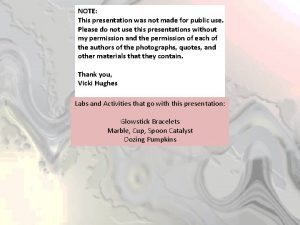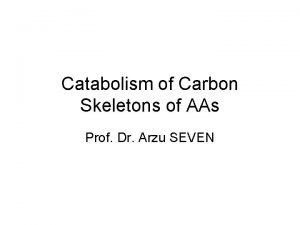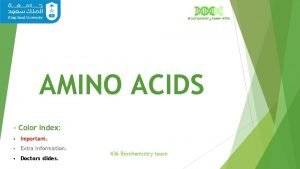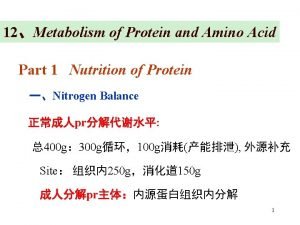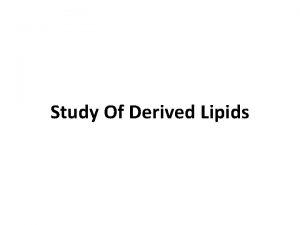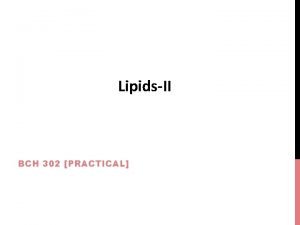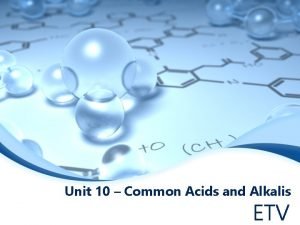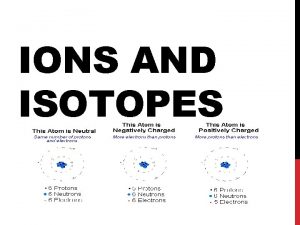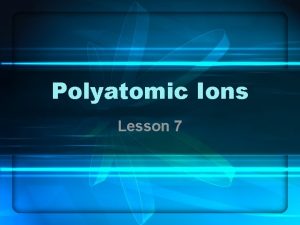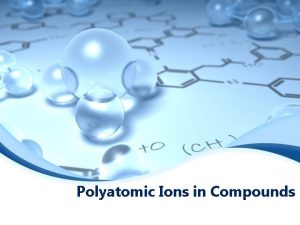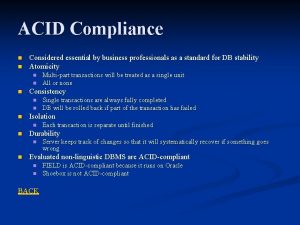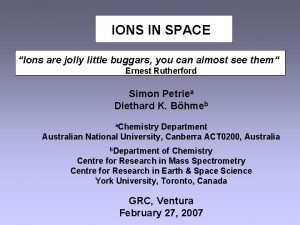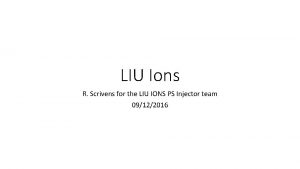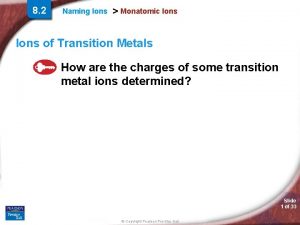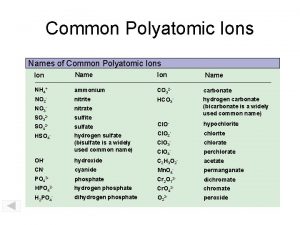Non Essential Ions Some ions considered non essential




































- Slides: 36


Non Essential Ions: Some ions considered non essential , even though some of em have a beneficial pharmacological ac in appropriate dosage. Particularly w F ‾ , it may be shown in future at is anion is essential w minimum daily requirements.

1 - Flouride F At. # = 9 At. Wt. = 19 * F r widely used today for eir anticariogenic ac ( inhibition of dental cavity development) *** wn F is taken orally , = 95% is absorbed, & balance is excreted in feces.

about 50% of ingested F is excreted in urine. While some F is excreted in perspiration , balance is retained in bone & is released very slowly to be excreted in urine.

- ere is considerable controversy concerning toxic doses for fluoride, usually in form Na. F. ere does not seem to be any harm in quantities used to fluoridate public water supplies.

*** Indeed , ere seems to be an excellent margin of safety (. ) effective dose of 2. 2 mg Na. F per day for preven of caries & acute lethal dose of 4 g. ** Na. F in toxic doses is a general protoplasmic poison w inhibits enz. activity.

Fluorine is an essential component of phosphates, as hydroxy-fluorapatite, a constituent of teeth & bones. It is essential for healthy & strong teeth & bones, & to avoid osteoporosis. * excess causes fluorosis, wi bone mottled & harder teeth &calcification.

Fluorosis is common where drainage water is high in fluorine, & is consumed w out adequate ttt (or caused by wine to w F ‾ has been added illegally in conc. of 15 -75 ppm to retard fermenta , can cause fluoride-induced arthritic changes).

Calcification of periarticular(near a joint) ligaments is responsible for restricted movement in hands shoulders & hip joints. 26 individuals living near a flouride-emitting factory & eating fluoride-contaminated food grown in area were reported to have preosteosclerotic (befor abnormal bone hardening) arthritis.

Lithium Li At. # = 3 At. Wt. = 7 * Li ion is a depressant to CNS & circula. ion has a diuretic ac. Its toxic nature led to discontinuance of Li. Cl as a component of salt substitutes used by patients on salt-free diets. Indeed , toxic effects of Li r aggravated by reduc in Na intake.

Li is readily absorbed from intestine & accumulates in body. extent of Li accumul is dependt upon Na intake. A ↓ intake of Na accelerates Li accumula & accentuates its toxic effects. Conversely, Li intoxication is treated by w-holding the Li salt & providing an adequate Na intake.

Li salts have been advocated at different times as CNS depressants. At one time Li. Br was official b of depressant ac of Br anion (Li was not considered a depressant at at time). supposed advantage of administering Li. Br was at ere was more Br available per uint weight of Li. Br since Li( At. Wt. 7)is so much lighter an Na(At. Wt. 23), ammonium(M. Wt. =18) or K(At. Wt. =39)

* current use of Li 2 CO 3 in manic-depressive disorders was due more to serendipity an to a careful screening of potential drugs. cation form a very water soluble ureate salt. It found bo Li urate & Li 2 CO 3 protected animals against convulsant death associated w toxic doses of urea. next step was to determine what effect Li salts would have on animals w out urea being admini. animals became lethergic. also it found Li should be investigated in mania b of eir sedative effect and in epilepsy b of eir anticonvulsant ac.

Li 2 CO 3 ; (Lithonate, Eskalith, Lithane) is admini. Orally in doses of 300 -600 mg 3 times a day to manic patients. - lower dose range is used for elderly patients in whom renal clearance is likely to be reduced. A phenothiazine tranquilizer usually is administered also for first few days since it takes 3 -10 days for Li to become effective. Li 2 CO 3 should be discontinued if a satisfactory response is not obtained in 14 days.

_ Since Li is toxic, serum Li levels should be monitored. A satisfactory range is 0. 5 -1. 5 m. Eq Li/l w- upper level for acute manic phases, & about 1 m. Eq/l for maintenance. Due to its toxic effects & b it is excreted by kidneys, if blood levels of Li r elevated Li 2 CO 3 is contraindicated in patient w impaired renal function. *Li can induced a diabetes insipidus condition by apparently interfering w- ac of vasopressin. also Li toxicity ↑ w- a ↓ in Na intake, patients on saltrestricted diets or ose who r receiving diuretics should be monitored carefully

Several toxic effects r being noticed now that Li 2 CO 3 is being widely used in a larger # of people. Li 2 CO 3 can effect: - thyroid func - causing myxedema(deficient thyroid func ) - ↓ protein –bound iodine levels - ↑ iodine uptake.

- Since Li is found naturally in certain public water supplies, ques arises as to whether popula s drinking water containing Li might not have a lowered incidence of manic-depressive rxs.

A comparative survey of cities near & distance from Li deposits showed at highest Li conc. Was 0. 1 m. Eq/l, a dose too small for any psychopharmacologic effect. On o er hand, a report of a Taxas study showed at as Li content of public water ↑, mental hospital admissions , it must be kept in mind at highest conc. of Li reported was 160 g/l(0. 023 m. Eq/l)w- is well below at found in previous study. but w-out any clinical criteria for its conclusion.

Gold Au ** Early use of gold salts in midicine was of an empirical nature, based largely on legend & folklore. -- Koch s discovery in 1890 at gold cyanide was effective in vitro against TB bacillus may be said to mark beginning of modren gold erapy

* is discovery led investigators to use various gold salts in ttt of many diseases believed to be TB in origin. current use of gold (chrysotherapy) in rheumatoid arthritis is based on early belief at this disease was an atypical form of TB.

* erapeutic gold cpds. r admini. by I. M. injec. gold rapidly enters plasma where it remains bound to albumin for several days. Gold is usually admini. on a weekly basis, since plasmagold levels remain fairly constant for a prolonged period.

Gold is toxic , it is slowly excreted by kidney and will accumulate in body. Regular determina s of plasma gold levels must be run for patient on gold erapy. Gold toxicity involves skin & mucous membranes , joints , blood, kidney, liver & nervous tissue. Much of time , cessa of gold administra & supportive ttt r adequate to remove toxic effects

If gold toxicity is sever, dimercaprol can be used to remove accumulated gold from body. Gold is used 1 ry in ttt of rheumatoid arthritis. is progressive , very painful & crippling disease is poorly understood. w possible exception of pig, ere r no good animal models of disease by w it can be studied & drugs evaluated.

Current hypotheses r based on an autoimmune mechanism , but triggering agent is unknow. disease is a chronic inflammatory disorder at mainly attacks joints & eir surrounding structures( muscles, tendons & o er connective tissue). joints of hands, wrists, feet, ankles, knees, elbows & hips r mostly afflicted.

although joints r 1 ry sites of disease, it can attack heart, lung, kidney & o er organic. triggering of inflammatory response involved release of a grp. of hydrolytic enzymes known as lysosomal enz. , w r contained in membrane sacs called lysosomes & r found in polymorphonuclear leukocytes , liver cells & cells of synovial membranes of joints.

- ese hydrolases include at least 20 different enz. s, including acid phosphatases , β-glucuronidases , lipases, proteases, sulfatases & esterases. Togethere is group of enz. s hydrolyzes phosphate esters, lipids, carbohydrates, proteins, N. A. , sulfate esters.

- Drug ttt include salicylates , w- Aspirin in high doses being drug of choice , corticosteroids, NSAI agents, gold cpds. & certain antimalarials. corticosteroids bring about dramatic relief. Unfortunately ey cannot be used on a chronic basis. It has been postulated at most of ese agents act by stabilizing lysosomal membranes, thereby reducing enzymatic breakdown of joint tissues.

Recently it has been suggested at aspirin & possibly o er NSAI agents act by blocking synthesis of certain PG at may take part in inflammatory process. ere r some question as to whether drugs used in rheumatoid arthritis actually stop progressive joint destruc . some of ese agents , gold include , may give symptomatic relief only.

* gold is admini. beginning w small doses & increasing dose until a total of 1 g has been admini. * ere is disagreement as to whether a 2 nd course of ttt should be instituted if 1 st course does not produce any beneficial results. Fur ere , it has not been decided if a patient in remission should receive maintenance gold ttt, or if ttt should be stopped untile disease begins again.

Gold has also been used in non-disseminated lupus erythematosus but is contraindicated in disseminated lupus. - Gold should not be given to individuals w renal disease, a history of infectious hepatitis, skin or blood disorders, diabetes, pregnancy, hypertension, or congestive heart failure. Prior to each injection it is recommended at a complete blood count & urinalysis be performed & patient questioned about signs of toxicity (rash, pruritus).

Official Gold cpds 1 - Aurothioglucose, (C 6 H 11 Au. O 5 S; M. Wt. =392. 18[1 -thio-D-glucopyronosato] gold)) -Aurothioglucose U. S. P. is an odorless or nearly odorless yellow powder w is stable in air. - An aq. Solu is unstable on long standing. -- the U. S. P. permits add of not more an 5% of Na. Acetate as a stabilizing agent. p. H of its 1 in 100 solu is about 6. 3.

Usual Dose: I. M. , 10 mg, ↑ to 25 mg, & en to 50 mg/ week to a total of 750 mg; en in ↓ ing amounts. If a patient has improved & no toxic effects have developed, a dose of up to 50 mg may be given at 3 -4 week intervals. Usual dose range: 10 -50 mg weekly

Occurrence: Aurothioglucose inj. (Solganol®) (contain 100% of labeled amount as a sterile suspension in a suitable vegetable oil w suitable thickening agents. Solganol® uses sesame oil w 2% aluminum monostearate. It is available in conc. of 50 -100 mg/ml

2 -Gold Sodium Thiomalate (C 4 H 3 Au. Na 2 O 4 S. H 2 O; MWt. =408. 09; Disodium mercaptosuccinato]gold) Gold sodium thiomalate U. S. P. is white to yellowish white, odorless, fine powder w is effected by light. It is very sol. in water & insol. in alc. , ether & most organic solvent. Usual dose: I. M. 10 mg ↑ to 25 mg & en to 30 mg / week to a total of 750 mg, en ↓ amounts. Usual dose range: 10 -50 mg weekly.

Occurrence: Gold Sodium Thiomalate inject. , . P. (Myochrysine®) (contain 100% of labeled amount as a sterile solu in water for injec . it is available as 10, 25, 50 mg in 1 ml and 500 mg in 10 ml.

Non. Official Gold products: 1 - Gold Sodium Thiosulfate, N. F. XII (Na 3 Au(S 2 O 3)2. 2 H 2 O; M. Wt. =526. 22) 2 - Aurothioglycanide (C 6 H 5 NHCOCH 2 SAu; Lauron®)
 Non essential ions
Non essential ions Atoms or ions are considered isoelectronic if
Atoms or ions are considered isoelectronic if What do the roman numerals in a cation's name indicate?
What do the roman numerals in a cation's name indicate? Characteristics of lipids
Characteristics of lipids Chemical formulas list
Chemical formulas list They say it only takes a little faith to move a mountain
They say it only takes a little faith to move a mountain They say it only takes a little faith to move a mountain
They say it only takes a little faith to move a mountain Cream countable or uncountable
Cream countable or uncountable Contact vs noncontact forces
Contact vs noncontact forces Some say the world will end in fire some say in ice
Some say the world will end in fire some say in ice Some say the world will end in fire some say in ice
Some say the world will end in fire some say in ice Some trust in horses
Some trust in horses Les promesses de dieu ne failliront jamais
Les promesses de dieu ne failliront jamais Non-essential nutrients
Non-essential nutrients Non essential amino acids in food
Non essential amino acids in food Non essential questions examples
Non essential questions examples Importance of vitamin a
Importance of vitamin a Non-essential nutrients
Non-essential nutrients Non-essential nutrients
Non-essential nutrients Non essential amino acids mnemonics
Non essential amino acids mnemonics Non essential amino acids mnemonics
Non essential amino acids mnemonics Non essential amino acids mnemonics
Non essential amino acids mnemonics Non essential ingredients examples
Non essential ingredients examples Defining non-defining relative clauses
Defining non-defining relative clauses Molecular structure of saturated fat
Molecular structure of saturated fat Non essential fatty acids
Non essential fatty acids Why is environmental science considered interdisciplinary?
Why is environmental science considered interdisciplinary? Why are viruses considered nonliving?
Why are viruses considered nonliving? 9-which acid is not considered a strong acid?
9-which acid is not considered a strong acid? What's considered a standard drink
What's considered a standard drink Norms of morality
Norms of morality Which kingdom is considered the “junk drawer”?
Which kingdom is considered the “junk drawer”? What is considered new england
What is considered new england Refrigerator and pantry are the major items here
Refrigerator and pantry are the major items here What is considered eastern europe
What is considered eastern europe The father of scientific management
The father of scientific management Kasap
Kasap




